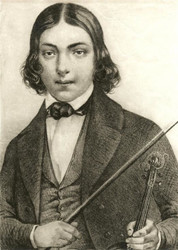Unveiling a Virtuoso's Vision: The Opus-Numbered Works of Henri Wieniawski - Part 1
Posted by Paul Wood on 22nd Apr 2025
Henri Wieniawski. The name itself conjures images of dazzling virtuosity, a Romantic-era titan wielding his violin with both breathtaking technical command and profound expressive depth. Born in Poland in 1835, Wieniawski wasn't just a performer; he was a composer who poured his unique understanding of the violin into a compelling body of work. His early admission to the Paris Conservatoire, a testament to his prodigious talent at a time when foreign students often faced stricter age requirements, set the stage for an international career that saw him captivate audiences across continents. The mid-19th century was a golden age for violin virtuosos, with figures like Paganini casting a long shadow and inspiring a new generation of performers to push the boundaries of the instrument. Wieniawski emerged into this exciting landscape, eager to make his own mark.
Crucially, Wieniawski's life as a touring virtuoso deeply informed his compositional activities. Many of his pieces were, in essence, self-portraits in music, designed to showcase the extraordinary capabilities he possessed. These weren't mere technical exercises; they were crafted with an innate understanding of the violin's voice, tailored for the concert hall. The vibrant musical scene of 19th-century Europe, with its burgeoning public concerts and enthusiastic audiences, provided the perfect platform for such displays of virtuosity.
This blog series embarks on a journey through the core of Wieniawski's compositional legacy: the twenty-four works he carefully selected to be published with opus numbers. This curated collection, despite hinting at a larger body of work (including pieces without opus numbers or those sadly lost), likely represents the compositions he deemed most significant, polished, and ready for wider appreciation. It's a fascinating window into the mind of a virtuoso who was equally passionate about creation.
We'll delve into each of these opus-numbered works, from the youthful exuberance of Op. 1 to the evocative finality of Op. 24. For each piece, we'll explore its historical context – the when, where, and why of its creation, including composition and publication dates, dedications, and any interesting stories surrounding it. But more importantly, we'll offer a glimpse into the musical heart of each work, touching upon its style, form, the technical demands it places on the performer, and its overall significance within Wieniawski's output and the broader violin repertoire.
The connection between Wieniawski the performer and Wieniawski the composer is the key to unlocking these pieces. The often-daunting technical challenges and the idiomatic writing for the violin aren't abstract hurdles; they are direct reflections of his own legendary technique and performance style. He pushed the boundaries of what was thought possible on the instrument, essentially codifying aspects of the "modern school" of violin playing in his time. The rise of concert life in the 19th century created a demand for such virtuosic display pieces, and Wieniawski was a master of the genre.
The enduring presence of these works in the violin repertoire, alongside the important work of scholars in producing critical editions of his complete works, speaks volumes about their lasting artistic and pedagogical value. Join us as we begin to explore this remarkable catalogue, starting with the formative early works that announced the arrival of a true violinistic visionary.

